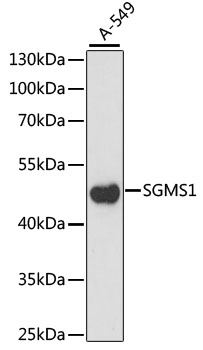-
Product Name
SGMS1 Polyclonal Antibody
- Documents
-
Description
Polyclonal antibody to SGMS1
-
Tested applications
WB
-
Species reactivity
Human
-
Alternative names
SGMS1 antibody; MOB antibody; MOB1 antibody; SMS1 antibody; TMEM23 antibody; hmob33 antibody; sphingomyelin synthase 1 antibody
-
Isotype
Rabbit IgG
-
Preparation
Antigen: Recombinant fusion protein containing a sequence corresponding to amino acids 1-134 of human SGMS1 (NP_671512.1).
-
Clonality
Polyclonal
-
Formulation
PBS with 0.02% sodium azide, 50% glycerol, pH7.3.
-
Storage instructions
Store at -20℃. Avoid freeze / thaw cycles.
-
Applications
WB 1:500 - 1:2000
-
Validations

Western blot - SGMS1 Polyclonal Antibody
Western blot analysis of extracts of A-549 cells, using SGMS1 antibody at 1:1000 dilution.Secondary antibody: HRP Goat Anti-Rabbit IgG (H+L) at 1:10000 dilution.Lysates/proteins: 25ug per lane.Blocking buffer: 3% nonfat dry milk in TBST.Detection: ECL Enhanced Kit .Exposure time: 930.
-
Background
Sphingomyelin synthases synthesize the sphingolipid, sphingomyelin, through transfer of the phosphatidyl head group, phosphatidylcholine, on to the primary hydroxyl of ceramide. The reaction is bidirectional depending on the respective levels of the sphingolipid and ceramide. Golgi apparatus SMS1 directly and specifically recognizes the choline head group on the substrate, requiring two fatty chains on the choline-P donor molecule in order to be recognized efficiently as a substrate. Major form in macrophages. Required for cell growth in certain cell types such as HeLa cells. Suppresses BAX-mediated apoptosis and also prevents cell death in response to stimuli such as hydrogen peroxide, osmotic stress, elevated temperature and exogenously supplied sphingolipids. May protect against cell death by reversing the stress-inducible increase in levels of proapoptotic ceramide.
Related Products / Services
Please note: All products are "FOR RESEARCH USE ONLY AND ARE NOT INTENDED FOR DIAGNOSTIC OR THERAPEUTIC USE"
